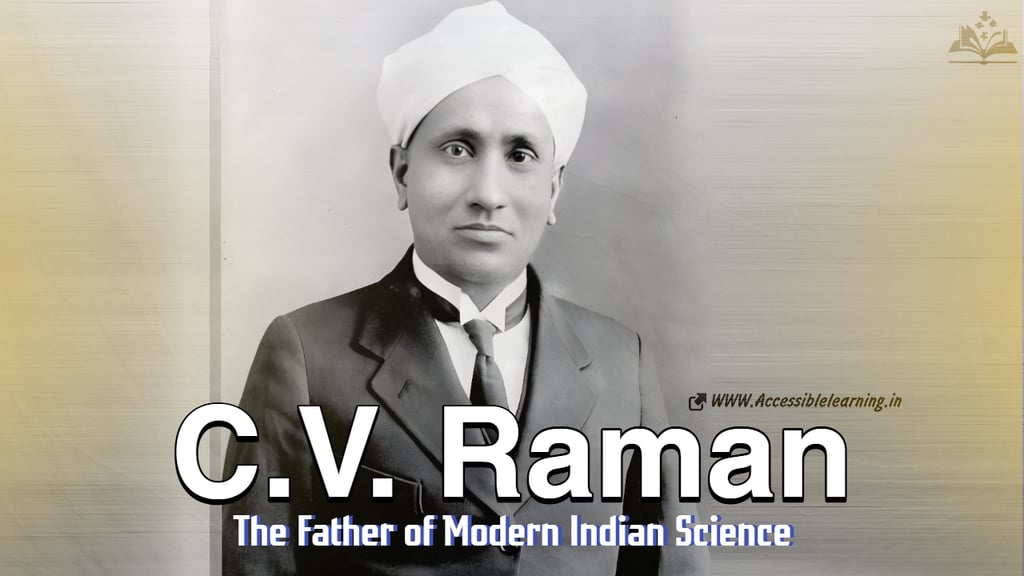
C.V. Raman: India's First Nobel Laureate in Science
The life, groundbreaking discoveries, and enduring legacy of C.V. Raman, the Indian physicist whose Nobel Prize-winning discovery of the Raman Effect revolutionized modern science. Learn about his contributions to physics, his visionary leadership, and his impact on India's scientific landscape.
BIOGRAPHYGREAT SCIENTISTINDIA/BHARATSCIENCE/PHILOSOPHY
Keshav Jha
1/30/20255 min read


Sir Chandrasekhara Venkata Raman Ji (सर चन्द्रशेखर वेंकट रमन), widely known as C.V. Raman, stands as one of India’s greatest scientific minds, whose contributions transformed the global understanding of light and matter. Best remembered for his discovery of the Raman Effect, which earned him the Nobel Prize in Physics in 1930, Raman’s work remains a cornerstone of modern physics and spectroscopy. This article delves into the life, achievements, and enduring legacy of this iconic scientist.
Early Life and Education
C.V. Raman was born on November 7, 1888, in the small town of Tiruchirapalli, Tamil Nadu, during British colonial rule. His father, Chandrasekhara Iyer (चंद्रशेखर अय्यर), was a lecturer in mathematics and physics, and his mother, Parvathi Ammal (पार्वती अम्मल), was a homemaker. Raman’s upbringing was steeped in an environment of learning and intellectual curiosity, which profoundly influenced his future pursuits.
Raman demonstrated exceptional academic talent from an early age. At just 16 years old, he graduated with a bachelor’s degree in physics from Presidency College, Madras (now Chennai), securing the top rank. He went on to earn a master’s degree in physics, during which he conducted his first research paper on diffraction of light. This paper was published in the prestigious journal Philosophical Magazine, a rare feat for a student in colonial India.
Despite his brilliance in physics, Raman initially joined the Indian Finance Service in 1907, working as an Assistant Accountant General in Kolkata. However, his passion for science remained undiminished, and he devoted his evenings and spare time to research at the Indian Association for the Cultivation of Science (IACS). This marked the beginning of his illustrious scientific career.
The Birth of the Raman Effect
Raman’s defining moment in science came during his voyage to Europe in 1921. While traveling on a ship, he was fascinated by the deep blue color of the Mediterranean Sea and questioned the prevailing explanation that it was due to reflection of the sky. This sparked his curiosity about the scattering of light by water and other transparent substances.
After years of meticulous experimentation, on February 28, 1928, Raman and his student K.S. Krishnan demonstrated the phenomenon now known as the Raman Effect. They showed that when light passes through a transparent medium, a small portion of it is scattered in different directions, and its wavelength changes depending on the molecular composition of the medium. This discovery provided a powerful method to study molecular structures and revolutionized the field of spectroscopy.
The Raman Effect was an extraordinary achievement, as it offered direct experimental proof of the quantum nature of light. Raman’s groundbreaking work earned him the Nobel Prize in Physics in 1930, making him the first Asian to win the award in a scientific field. This achievement not only brought global recognition to Indian science but also demonstrated the potential of Indian researchers to make significant contributions on the world stage.
The Impact of the Raman Effect
The Raman Effect is not merely a theoretical concept; it has practical applications across diverse fields. It forms the basis of Raman spectroscopy, a technique used to identify the molecular composition of materials. Some key applications include:
Medical Diagnostics: Raman spectroscopy is used in detecting cancer and other diseases by analyzing biological tissues.
Material Science: It helps in studying the properties of new materials, including nanomaterials and polymers.
Environmental Monitoring: Raman spectroscopy aids in detecting pollutants and analyzing water quality.
Forensic Science: The technique is employed in crime scene investigations to identify unknown substances.
Astronomy: Raman spectroscopy is used in planetary exploration to analyze the composition of extraterrestrial surfaces.
A Visionary Leader in Science
Beyond his research, C.V. Raman was a passionate advocate for the advancement of science in India. In 1933, he became the first Indian director of the Indian Institute of Science (IISc), Bengaluru. During his tenure, he transformed the institute into a hub of scientific innovation and mentored numerous students who went on to become prominent scientists themselves.
In 1948, Raman founded the Raman Research Institute in Bengaluru, using his personal resources. The institute became a center for advanced research in various fields of physics, including optics, acoustics, and molecular biology. Raman was deeply committed to nurturing young talent and believed in the importance of fostering curiosity and independent thinking among students.
Raman was also an eloquent speaker and writer who emphasized the role of science in nation-building. He often spoke about the need for India to invest in indigenous research and reduce dependence on foreign technology. His vision laid the foundation for India’s post-independence focus on scientific and technological self-reliance.


Awards and Recognition
C.V. Raman’s contributions earned him numerous accolades, both in India and abroad. Apart from the Nobel Prize, he was knighted by the British government in 1929. After India gained independence, he received the Bharat Ratna, the country’s highest civilian honor, in 1954. Additionally, he was elected as a Fellow of the Royal Society and received several honorary doctorates from prestigious universities around the world.
Raman’s work continues to inspire global scientific communities, and the Raman Effect is still celebrated as a pivotal discovery in physics. February 28, the day of his discovery, is commemorated as National Science Day in India, fostering scientific awareness and enthusiasm among students and researchers.
Personal Life and Philosophies
C.V. Raman was known for his disciplined lifestyle and unrelenting work ethic. He married Lokasundari Ammal in 1907, and the couple had two sons, Chandrasekhar and Radhakrishnan. Raman’s personal life was marked by simplicity, and he often expressed his love for music, especially the violin. His interest in acoustics and the physics of musical instruments was an extension of his scientific curiosity.
Raman firmly believed in the power of observation and experimentation. He often said, “The essence of science lies in independent thinking and hard work.” His emphasis on self-reliance and originality continues to resonate with scientists and innovators.
A Legacy That Shines On
Raman passed away on November 21, 1970, but his legacy endures in countless ways. National Science Day, celebrated annually in India on February 28, commemorates the discovery of the Raman Effect and promotes scientific awareness.
Several institutions, awards, and scholarships bear his name, honoring his contributions to science and education. The Raman Research Institute remains a leading center for advanced research, and Raman spectroscopy continues to be a vital tool in scientific exploration.
Raman’s journey from a small town in Tamil Nadu to global acclaim is a testament to the transformative power of curiosity, perseverance, and intellectual rigor. His work not only advanced scientific knowledge but also inspired a generation of Indian scientists to dream big and achieve greatness.
Contributions Beyond Physics
In addition to his work on light scattering, Raman made significant contributions to other fields of physics. He conducted pioneering research in acoustics, particularly on the vibration of musical instruments such as the violin, mridangam, and tabla. His work provided deep insights into the harmonic properties of these instruments, bridging the gap between science and art.
Raman also explored the optical properties of gemstones, leading to a better understanding of their coloration and structure. His studies on diamonds and other crystals opened new avenues in material science and helped establish the scientific foundation for the gemstone industry.
C.V. Raman Ji’s life is a shining example of how determination and curiosity can lead to groundbreaking discoveries. From unraveling the mysteries of light scattering to nurturing India’s scientific infrastructure, his contributions have left an indelible mark on the world. His discovery of the Raman Effect forever changed the scientific landscape, and his vision for India’s scientific growth remains as relevant today as it was during his lifetime.
As we celebrate his achievements, let us remember his words: “The true wealth of a nation lies in its intellectual and scientific heritage.” Raman’s legacy serves as an enduring reminder of the power of science to illuminate the path to progress and prosperity.
Subscribe To Our Newsletter
All © Copyright reserved by Accessible-Learning Hub
| Terms & Conditions
Knowledge is power. Learn with Us. 📚




